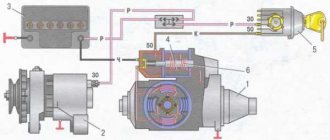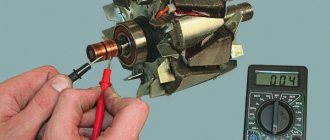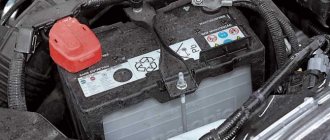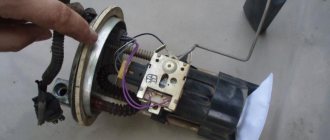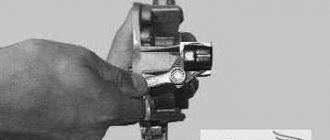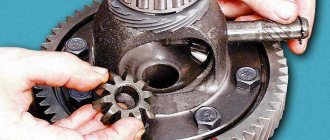A starter is an element of a vehicle - an electric motor that has 4 poles. He starts the engine in the car. As for the principle of its operation, it is based on the fact that it transmits the initial stroke to the engine crankshaft. Thanks to the 4 brushes of this device, the level of power and torque increases. Of course, if the starter is faulty, the engine cannot be started.
Also on the website read everything about tuning the interior of the VAZ 2106
Starter circuit for VAZ 2101, 2102, 2103, 2104, 2105, 2106, 2107
First, let's take a closer look at the VAZ 2101, 2102, 2103, 2104, 2105, 2106, 2107 starter circuit.
VAZ "classics" starter circuit
Deciphering the starter circuit for VAZ 2101, 2102, 2103, 2104, 2105, 2106, 2107:
- — drive side cover;
- — retaining ring;
- — restrictive ring;
- — drive gear;
- — overrunning clutch;
- - drive ring;
- — rubber plug;
- — drive lever;
- — relay anchor;
- — holding winding of the traction relay;
- — pull-in winding of the traction relay;
- — relay coupling bolt;
- — contact plate;
- — relay cover;
- — contact bolts;
- — collector;
- - brush;
- - armature shaft bushing;
- - cover on the collector side;
- — casing;
- — shunt coil of the stator winding;
- - frame;
- — stator pole fastening screw;
- - anchor;
- — armature winding;
- - intermediate ring.
Starter connection diagram for VAZ 2101, 2102, 2103, 2104, 2105, 2106, 2107
Deciphering the starter connection diagram for VAZ 2101, 2102, 2103, 2104, 2105, 2106, 2107:
- — generator;
- - accumulator battery;
- — starter;
- ignition switch;
P1 - pull-in winding of the traction relay;
P2 - holding winding of the traction relay.
Features of battery operation
Successful engine starting will depend on the condition and power of the battery. Many people know that such indicators as capacity and cold cranking current are important for batteries. These parameters are indicated on the marking, for example, 60/450A. Capacity is measured in Amp-hours. The battery has low internal resistance, so it can deliver large currents for a short time, several times its capacity. The specified cold cranking current is 450A, but subject to certain conditions: +18C° for no more than 10 seconds.
However, the current supplied to the starter will still be less than the specified values, since the resistance of the starter itself and the power wires is not taken into account. This current is called inrush current.
The battery supplies starting current to the starter for 5-10 seconds. Then you need to pause for 5-10 seconds for the battery to “gain strength”.
If, after attempting to start, the voltage in the on-board network drops sharply or the starter cranks halfway, this indicates a deep discharge of the battery. If the starter makes characteristic clicks, then the battery is completely dead. Other reasons may include a broken starter.
The starter of VAZ 2101, 2102, 2103, 2104, 2105, 2106, 2107 does not start
What signs indicate that the starter needs to be repaired or is time to be replaced? Why does the starter sometimes not start?
These questions have their own answers:
- The relay functions without problems. However, the anchor does not respond or makes slow rotational movements. Solution ! As a rule, this is due to burning of the collector. It is also necessary to pay attention to the winding. It must be complete. It is also possible that the relay fastening elements are loose, there is a short circuit in the commutator, the brushes are stuck or have become completely unsuitable for further use. However, the reason may lie in a discharged battery.
- The starter responds, but the armature relays do not function. Solution ! Often the whole point is that the anchor is stuck. In this case, it is worth checking how the tips are fixed. Is there a short to ground and what is the condition of the wiring?
- The armature rotates, but problems arise with the crankshaft. Solution ! It's worth checking the buffer spring. Most likely it's broken. Some components of the coupling may be damaged.
- Powerful noises are heard. This is often the result of damaged bushings and gears.
- In turn, the starter turns, but does not start. You need to take a closer look at the return spring. The device may also be skewed. It is also possible that the relay and drive handle are jammed.
The fastest and most cost-effective upgrade is installing coolers
The standard heater of the VAZ 2105 does not always cope with cold winter weather. Do-it-yourself modification of the VAZ-2105 stove will not require too much labor and money if the car owner decides to modify the standard equipment by installing coolers on the side deflectors. It is worth noting that absolutely everyone should improve the heating equipment of the VAZ-2105, since due to the irrational design, all the air entering the cabin goes down. Thanks to the installation of coolers, which are usually included with PCs, you can adjust the air flow going to the sides. Experts recommend purchasing devices that can make at least 1500 revolutions per minute. Despite the fact that a do-it-yourself modification of the VAZ-2105 stove will not require much expense and time, it will help increase the level of comfort.
Replacing the VAZ “classics” starter
The most common reason why the starter on a “classic” becomes faulty is the inoperability of the retractor relay with which it is equipped. That is why, when turning the key, the driver will hear a characteristic click. Consequently, the engine will not start in this case.
True, sometimes it is necessary to completely replace the starter. But first you need to dismantle the old starter. To do this, use the key to “thirteen”.
Replacing the starter consists of the following steps:
- We remove the battery.
- Then you need to find the fasteners.
- Then you need to unscrew the 2 bolts.
We unscrew the bolts.
Then you should pull the starter and move it towards the right. So it will move away from its previous position and shift to the right side. - Next, you need to lift the left side of the starter and turn it upside down. It is pulled up all the way.
- This element of the vehicle should be lifted until the wiring located at the rear of the starter becomes accessible and the wires can be removed.
- There are 2 wires at the back. One of them is fixed using a standard nut, which initially needs to be unscrewed.
Unscrew the power cable nut - A simple plug serves as the second nut. It needs to be moved to the side. It can be dismantled without much effort.
- Once the starter is free, it can be easily removed.
As for installing a new starter, it is carried out in the reverse order. This procedure will not take much time. It is recommended that you perform these steps in a specific sequence.
In other words, you first need to connect the wires to the starter, and only then install it in its original place. At the same time, the price of a new starter for a six ranges from 2 to 4 thousand rubles. It all depends on the manufacturer and modification of the device itself.
Device
You may be interested in: How to clean carbon deposits from pistons? Methods and means for cleaning pistons from carbon deposits
A mechanism such as a starter plays a very important role in the starting system of the VAZ-2105. It is an electric motor with a voltage of 18 volts. The block consists of the following elements:
- starter anchor;
- collector plates;
- poles, or cores;
- overrunning clutch (Bendix);
- steel cylinder.
The device also includes 4 excitation windings located inside the walls of the block housing. The VAZ-2105 starter injector has a similar structure. The service life of this part may vary. Typically, breakdowns occur no earlier than the car has traveled 80-90 thousand km, and with regular maintenance this figure can be up to 150,000 km.
You will be interested in: “Nissan Qashqai”: dimensions, description, characteristics and reviews
Starter repair VAZ 2101, 2102, 2103, 2104, 2105, 2106, 2107
Repairing such a vehicle element as the VAZ 2101, 2102, 2103, 2104, 2105, 2106, 2107 starter is a rather painstaking process. The driver must have good self-control and strictly follow certain instructions. Then repairing the starter yourself will go smoothly.
So, it is necessary to repair the starter in the following sequence:
- Remove the old starter from the engine.
- Using a key set to “thirteen”, loosen the nut securing the wiring, which contains the traction relay.
- Disconnect the cable end.
- Apply a voltage equivalent to twelve volts to the relay output.
We supply 12 volts to the starter - Change the housing pole to a negative value. As for the ohmmeter, this device should be connected to contact-type bolts. At the same time, if the solenoid relay is repaired, the armature pulls the so-called “overrunning clutch” into the window of a special cover, which is located in front. But the contact type bolts must be closed.
- Taking a Phillips screwdriver, you need to unscrew the 3 screws.
Unscrew the bolts of the retractor relay - We dismantle the traction relay.
- We free the relay body from the rod, which is equipped with a spring.
- We install a new traction type relay using the reverse sequence.
- To continue further disassembly of the starter using a Phillips screwdriver, unscrew 2 screws.
- It's time to remove the cover.
- In order to check the current condition of the brushes, we use a slotted screwdriver. It unscrews the fastening screw that secures the contact wire.
- When the spring is released, you need to remove the brush. The same method is used to remove the 3 remaining brushes. If the latter have wear of up to 12 mm or less, then they need to be replaced.
- Next, you need to connect the ohmmeter one by one to the terminals of the stator windings. They are checked for short circuits. You should also make sure that the separately located winding terminals do not come into contact with the housing.
Checking the short to body - Use a screwdriver to pry up the retaining ring and remove it.
- We remove the washer from the axle.
- Using a ten key, remove the 2 coupling nuts.
- Then we remove them.
- We disconnect the starter body and remove it from the insulating tubes of the tension type bolts.
- We take a quick look at the commutator and windings. You should never leave charred windings. If the collector has been slightly burned, it is necessary to clean the existing plates with abrasive sandpaper. When severe burning has occurred and serious wear has occurred, it is recommended that the anchors be replaced. As for scuffing and enveloping of bronze relating to the bearings on the special neck of the armature shaft, they are removed using fine-grained sandpaper and are subsequently polished.
- Next, we take the ohmmeter again and check the armature winding to ensure there is no short circuit. A damaged anchor must be replaced.
Checking the armature windings - We release the drive cover from the rubber seal.
- Remove the adjustment washer from the armature axis. During the assembly process it must be returned to its original place.
- The lever axis is being uncoiled.
- You need to use a special bit to select the axis.
- We remove both the anchor and the drive.
- We pry it up with a screwdriver and remove the overrunning clutch drive lever.
- As for the gear, it must make rapid rotational movements in one direction and not move in the opposite direction. Also, it should not be accompanied by chips or nicks that may appear in the leading area of the teeth. When the gears are worn out or the clutch is faulty, the assembly requires replacement.
- Having placed the anchor axis, using a block of wood for these purposes, using a key set to “thirteen” we knock the limiter off the locking type ring.
- We pry it up with a screwdriver and remove the retaining ring.
- We free the axle from the limiter and the overrunning clutch assembly. The drive gear is also dismantled.
- Having replaced the coupling assembly, we return the locking ring to its original place and attach the limiter with part of the conical groove to the winding part of the armature.
- The limiter must be pressed onto a locking ring. To do this, use a hammer to strike. We also use the key for “thirteen”.
- Using compressed air, we remove the coal dust that has accumulated in the body and brush holder. As for the wiring ring and the plastic surfaces in contact with it, they must be treated with Litol-24. Lubricant number 158 is also suitable. In this case, we use engine oil, which is necessary for processing the rotor bushing, screw splines of the armature shaft and hubs touching the overrunning clutch.
- Further assembly is carried out in the opposite order to disassembly.
Diagnostics
To understand which part of the starter the breakdown occurred in, you should thoroughly clean it. First, the solenoid relay is checked. If it is working properly, a loud click will be heard. Another evidence of the serviceability of this mechanism is that the bendix moves slightly forward. The absence of a click indicates that the relay is broken and needs to be replaced with a new one.
If the problem is not in this part, then you need to make sure that all the insulation is in good condition. All damage can be restored with impregnating varnish and then checked with special electrical measuring instruments.
When, after a complete inspection, all parts are found to be in good condition, the rotor insulation must be checked. Traces of burning and soot on the anchor indicate that this device needs to be replaced. The collector must be clean, free of deposits, and if this defect is present, you can clean the element with sandpaper. After all procedures, the coupling is checked. It should spin freely in one direction and be locked in the other.
Starter relay VAZ 2101, 2102, 2103, 2104, 2105, 2106, 2107
The structural structure, which has a VAZ 2106 starter solenoid relay, has a complex structure. At the same time, many drivers who more or less understand the details of the “six” can disassemble it with their own hands.
As for subsequent assembly, not every motorist can cope with this task. In this case, it is best to trust the professionals.
If you think the relay needs to be replaced but are not sure, it needs to be thoroughly inspected. It is noteworthy that the relay in the six functions similarly to other elements installed in various vehicle models. That is, it performs the functions of an electromagnet.
To check its condition, it is closed with a metal object. For example, you can use a screwdriver. If the starter begins to make rotational movements, then the starter relay will indeed need to be repaired. When clicks are heard from the retractor-type relay, but the starter rotates, then it is the latter that is broken.
Why does the starter relay stop working? There are several answers to this question. The problem may be due to outdated parts (the material deteriorates over time). The winding also . In this case, the reason may lie in the combustion of nickels , which are located in the internal part of the relay itself.
However, for a novice driver who has not previously done repairs, it is necessary to find out where the VAZ starter relay is located. If he does not want to waste his time and think about how to disassemble this part (by the way, there is a visual diagram of the relay, and you can buy all the spare parts yourself), then he can turn to professionals. They will not only disassemble this part, but will also connect the relay. In this case the price will be minimal.
Starter solenoid relay
If the starter is safely removed from under the hood, it must be cleaned. Contaminants are removed from it. As for oxidized contacts, they are processed using sandpaper.
Diagnostics of the starter solenoid relay:
- The starter is located near the battery. In this case, 2 electrical wires are prepared, which must be of sufficient length. Wires intended for “lighting” are ideal. They are equipped with so-called “crocodiles”.
- Initially, the positive terminal is connected to the battery (the corresponding output of the solenoid relay) via one electrical wire.
- Then the other wire is connected to the battery terminal, which has a negative value.
- Finally, you need to touch the free unoccupied end of the electrical wire with a negative value. This contact must take place with the starter housing. Further actions will depend on the results obtained.
If during the connection process the solenoid relay makes a quick and distinct click, then it is operating normally. When the part does not show any signs of “life,” the solenoid relay must be repaired or completely replaced.
What exactly is making noise and why?
Let's try to understand this issue. The main causes of noise coming from the gearbox are:
- improper operation of the gearbox, in particular the use of counterfeit transmission fluid purchased on the black market and operation of a vehicle with a non-working clutch;
- poor quality of gearbox components;
- maximum service life of manual transmission;
- unskilled technical work on diagnostics and repair of gearboxes.
In addition, the main malfunctions that can result in noise in the gearbox are:
- sudden difficulty switching on speed: in order to engage one or another gear, the driver will sometimes need to move the gearbox lever several times to the neutral position with the clutch depressed;
- The box automatically switches off the car’s gear while driving;
- Transmission fluid may leak from the gearbox.
It should also be noted that the VAZ 2109 gearbox can make noise in various conditions: at neutral speed, while shifting gears, or simply while driving at a certain speed. And each of these noises can indicate a different malfunction of the box.
In addition, during diagnostics, one must not forget that only one external sign may indicate several malfunctions in the gearbox. Therefore, it is virtually impossible to visually (i.e., by the type of hum) calculate which component of the box has failed. The damage can only be determined by removing and disassembling the box.
It is also necessary to add that repairing a transmission and eliminating defects requires a lot of knowledge, so it is better not to do this at home. The gearbox is an important unit in the structure of any vehicle, so it is better to entrust its repair and diagnostics to a qualified specialist.
Often the hum of the unit manifests itself:
- when you press the clutch;
- when turning on the third and fourth speeds;
- at neutral speed;
- when driving a car at high speeds.
Most domestic VAZ 2109 car owners face such problems. But if when you press the clutch, extraneous sounds disappear, then this may indicate several breakdowns. In particular, the fifth speed or reverse gear may fail. In addition, the input shaft bearing or release bearing may be faulty.
As practice shows, in the case of bearings the problem is not critical. If noise appeared in your car and then disappeared after several hundred or thousand kilometers, then most likely the remaining bearings were simply ground up by the unit system.
If your VAZ 2109 starts making noise, this does not mean that the bearings or reverse gear have failed. These problems are the most common, but only high-quality diagnostics can specifically determine what has gone wrong.
